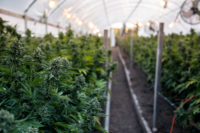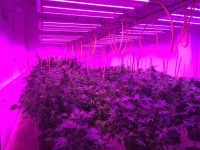What do Aurora Cannabis, Tilray and Pfizer all have in common? They all produce and sell products used for medicinal purposes, they are top competitors in their field and they all have statements on their websites claiming that science is one of the most important things to their business. But unlike Pfizer, Aurora and Tilray do not have any positions in the executive suite for scientists or medical personnel. This led us to wonder, why does the structure of their corporate ladder (as well as so many other cannabis companies) not align with what they claim to be their values?
According to Aurora Cannabis, “Science is at the core of what we do”.1 Look up the definition of “core” and you will get “foundational, essential, central, and enduring.”2 Sounds important. Meanwhile, Tilray’s main page states: “For the therapeutic value and risks of cannabinoid-based medicines to be fully understood, Tilray believes it is critical to evolve current scientific understanding of the field.”3
 You would assume that somebody in the executive suite would have a position and an educational background relating to the central and enduring part of a business, right? We looked at 10 of the biggest Canadian cannabis companies, their founders’ educational backgrounds and whether there were executive positions for science, R&D or medicine (Table 1). We also looked at the same data for the top 10 biggest pharmaceutical companies (Table 2). As expected, every pharmaceutical company had upper-level (C and/or P level) positions for scientists and/or medical personnel. However, only 2 of the 10 cannabis companies had this.
You would assume that somebody in the executive suite would have a position and an educational background relating to the central and enduring part of a business, right? We looked at 10 of the biggest Canadian cannabis companies, their founders’ educational backgrounds and whether there were executive positions for science, R&D or medicine (Table 1). We also looked at the same data for the top 10 biggest pharmaceutical companies (Table 2). As expected, every pharmaceutical company had upper-level (C and/or P level) positions for scientists and/or medical personnel. However, only 2 of the 10 cannabis companies had this.
 To figure out why this is, (as scientists) we did some research. It turns out, the consensus is scientists are bad at commercialization. Scientists are rarely successful as CEOs because they are (usually) not good at attracting customers and get confused by things like revenue models.4 As Akshat Rathi bluntly put it, “just because you are the smartest person in the building does not make you capable to run a company.” In fact, many CEOs of life science companies got to the top by pursuing business, finance, marketing or sales. In the 90s, some life science companies took a chance on scientists and hired them as CEOs, but when they hit financial turmoil, they quickly undid this.5
To figure out why this is, (as scientists) we did some research. It turns out, the consensus is scientists are bad at commercialization. Scientists are rarely successful as CEOs because they are (usually) not good at attracting customers and get confused by things like revenue models.4 As Akshat Rathi bluntly put it, “just because you are the smartest person in the building does not make you capable to run a company.” In fact, many CEOs of life science companies got to the top by pursuing business, finance, marketing or sales. In the 90s, some life science companies took a chance on scientists and hired them as CEOs, but when they hit financial turmoil, they quickly undid this.5
So maybe scientists aren’t always cut out to be the CEO of a company. But that still doesn’t explain why so few large cannabis companies have a chief scientific/medical officer, or even a president of R&D.
Maybe we are looking in the wrong place. Maybe their value of science can be demonstrated by their spending on research. Typically, a larger agricultural company will spend 9% or more on R&D, and a smaller company will spend 2-4%.6 Meanwhile, the major pharmaceutical companies we looked at spent between 12 and 25% of their revenue on R&D during their most recent fiscal year. Since a cannabis company falls somewhere in between we approximate they would spend around 9-12%.
 However, Canopy Growth was the only company that fell into our prediction range, spending 10.5% of their revenue on R&D in 2021.7 Tied for a distant second place were Charlotte’s Web and Aurora Cannabis (a subsidiary of Tilray), spending 4.6%. At the very bottom were Tilray which only spent 0.16% on R&D and TerrAscend which spent 0.21% during their most recent fiscal year.8,9 With most of the cannabis companies, we saw a gradual decrease in R&D funding over time, which intensified with the Covid-19 pandemic.
However, Canopy Growth was the only company that fell into our prediction range, spending 10.5% of their revenue on R&D in 2021.7 Tied for a distant second place were Charlotte’s Web and Aurora Cannabis (a subsidiary of Tilray), spending 4.6%. At the very bottom were Tilray which only spent 0.16% on R&D and TerrAscend which spent 0.21% during their most recent fiscal year.8,9 With most of the cannabis companies, we saw a gradual decrease in R&D funding over time, which intensified with the Covid-19 pandemic.
So why the heck are these companies going on about how they value science? To give them the benefit of the doubt, maybe they do think they value science, but they don’t know how to value it.
It’s hard for a company to take actions that show they value science if there are no voices for scientists at the executive level. After all, how can you make decisions based on science if nobody in the room understands it? Sure, we saw the argument that people who make it to the top can “learn enough science to ascend to the executive suite without much trouble”.5 But what is “enough science”? The mitochondria is the powerhouse of the cell?
 This leads to our argument for putting scientists in the executive suites of cannabis companies and giving them a more powerful voice. Whereas scientists are not good at marketing, those in managerial roles tend to overly rely on intuition – even when the evidence is against them.10 For those relying on intuition, R&D is an easy target during times of crisis (like a global pandemic). Cutting costs in R&D yields a short-term immediate increase in profit and the negative impacts are often not felt until years later.11 However, cutting R&D investment is the opposite of what you should do during a time of crisis. Evidence suggests companies that maintain or even increase spending in marketing and R&D and focus on operational efficiency (such as process optimization) are the ones that will come out as the top competitors in the long run.12,13 Having a chief scientific officer or an executive for R&D with a scientific background can help sustain companies by promoting R&D during hard times and indicating what projects will be the most promising to help the company optimize their processes.
This leads to our argument for putting scientists in the executive suites of cannabis companies and giving them a more powerful voice. Whereas scientists are not good at marketing, those in managerial roles tend to overly rely on intuition – even when the evidence is against them.10 For those relying on intuition, R&D is an easy target during times of crisis (like a global pandemic). Cutting costs in R&D yields a short-term immediate increase in profit and the negative impacts are often not felt until years later.11 However, cutting R&D investment is the opposite of what you should do during a time of crisis. Evidence suggests companies that maintain or even increase spending in marketing and R&D and focus on operational efficiency (such as process optimization) are the ones that will come out as the top competitors in the long run.12,13 Having a chief scientific officer or an executive for R&D with a scientific background can help sustain companies by promoting R&D during hard times and indicating what projects will be the most promising to help the company optimize their processes.
Having a scientist in the executive suite can also help keep everyone in check. “Senior execs live in a feedback loop of positive reinforcement making them unlikely to question their decisions,” according to Stefan Thomke and Gary Loveman.10 They claim the best way for those in managerial roles to avoid over relying on instinct and break out of that positive feedback loop is by “thinking like a scientist”. This involves not letting bias get in the way of truth, studying anomalies, being skeptical, developing strong hypotheses, producing hard evidence and probing cause and effect. To add to this, we think a major part of thinking like a scientist is by having at least one high up in the team. In our own company, giving equal value to scientific voices has resulted in all parties learning and thriving by making fact-based decisions.
Finally, scientists deliver! To be a scientist (with a PhD), one must master the field, find a gap in the knowledge, then fill that gap – all for little pay and no guarantee of a job at the end. This makes them dedicated workers whose main goal is to contribute something unique to their field, or in this case, their company.14 Having someone up top who is dedicated, passionate, innovative and trained to look for gaps in knowledge can be an invaluable voice in the executive suite. They are likely to point out potential money-saving solutions (i.e.: optimizing extraction conditions) that others up top may not have thought of on their own.
If you feel strongly that science is at the core of what you do, and you already know that R&D is crucial for the long-term survival of your company, you are already on the right track. In addition to this, consider giving a voice to scientists at the executive level in your company. The cannabis industry is still in its infancy. This means there is potential for R&D in more than just new product development. Basic stuff like extraction, modifying plants to be heartier against harsh conditions and pathogens, curing and safety testing processes have all barely been studied and optimized to reduce costs. These things won’t be solved by a Juris Doctor, an MBA or even an engineer, they will be solved by scientists, and it will take a scientist up top to ensure the whole company recognizes the importance of these projects.
Table 1: Top cannabis companies stats on founders and their educational backgrounds, presence of scientific executive positions and spending on research and development
| Company | Founders | Founder’s Educational Backgrounds | Science executive position? | % Revenue spent on R&D |
| Aphria Inc.
(now owned by Tilray)
|
Cole Cacciavillani and John Cervini | Cole: B. Eng
John: Born into a family greenhouse business |
Chief science officer
Garry Leong: B.Sc. Chem, M.B.A. Quality Management 15 |
NA |
| Canopy Growth Corp
|
Bruce Linton and Chuck Rifici | Bruce: Ba Public Policy, Minor: Economics. 16
Chuck: B. Eng, MBA |
no | 10.5% 17 |
| Aurora Cannabis Inc.
(subsidiary of Tilray) |
Terry Booth, Steve Dobler, Dale Lesack and Chris Mayerson | Terry: Master Electrician18
Steve: B. Eng Chris: Concrete business Dale: Electrician and homebuilder |
no | 4.6% 19 |
| Village Farms International Inc.
|
Michael A. DeGiglio | BSc Aeronautic Science | no | No data available on R&D expenses |
| Tilray Inc
|
Brendan Kennedy, Christian Groh, Michael Blue | Brendan: Ba. Architecture, Msc: Eng, MBA20
Christian: Ba. unknown, MBA21 Michael: Ba. Finance, MBA22
|
no | 0.16% 23 |
| Ayr Wellness Inc
|
Jonathan Sandelman | Juris Doctor, Law Degree24
|
no | No data on R&D spending available |
| TerrAscend Corp
|
Michael Nashat | Pharm. D . Post doc in Neuroscience25 | no | 0.21% 26 |
| HexoCorp
|
Sebastien St-Louis | Ba. Economics, MBA 27
|
no | 3.09% 28 |
| Fire & Flower Holdings Corp
|
Trevor Fencott | Ba (unknown), and Law degree29 | no | No data on R&D spending |
| Zenabis Global Inc
(now owned by hexo corp) |
Rick Brar, Mark Catroppa, Monty Sikka | Rick: Ba. (unknown)
Mark: Ba. Finance 30 Monty: Ba Accounting and Finance31
|
Chief science Officer:
Natasha Ryz PhD experimental medicine.32
|
NA |
Table 2: Top pharmaceutical companies founders and their educational background, presence of executive positions for scientists and spending on R&D
| Company | Current Executives | Educational Background | Science executive positions? | % Revenue spent on R&D |
| Amgen | Robert A. Bradway | BSc. Biology, MBA33
|
Chief Medical officer: Darryl Sleep, M.D. 33
Senior VP in R&D: Jean-Charles Soria PhD molecular Biol, MD |
18.5% 34 |
| Sanofi | Paul Hudson | Ba. Economics, honorary doctorate in business35
|
Executive VP, R&D:
John Reed, MD, PhD in Immunology35 |
14.51% 36 |
| Bristol-Myers Squibb | Giovanni Caforio | MD.37
|
Chief Medical Officer: Samit Hirawat, MD.
Rupert Vessey: Executive VP: R&D PhD molecular immunology 37
|
24.58% 38 |
| Takeda | Christophe Weber | PhD. pharmacy and pharmacokinetics, Msc. pharmaceutical marketing, accounting, and finance39
|
Director
President, R&D: Andrew Plump, MD. Ph.D. in cardiovascular genetics 39 |
14.25% 40 |
| AbbVie | Richard A. Gonzalez | No college degree. Practical experience in biochemistry research. | Vice chairman and president, R&D:
Michael E. Severino, MD, Bsc biochem41
|
12.60% 42 |
| Novartis | Vasant Narasimhan | Bsc. Biology, MD, Msc Public policy | President, Biomedical research, James Bradner M.D.
President innovative medicine, Victor Bulto: Msc. Chemical engineering, health economics, and pharmaeconomics, MBA. Chief medical officer, John Tsai BEng. MD43
|
18.04% 44 |
| Merck | Robert M. Davis | Ba Finance, MBA, Juris Doctor45
|
Executive VP and president of Merck Research Laboratories; Dean Li MD, PhD cardiology45 | 25.14% 46 |
| Johnson & Johnson | Joaquin Duato
Vanessa Broadhurst Peter Fasolo |
Joaquin: MBA, Master of international management
Vanessa: Ba, Master of Business Administration Peter: PhD in organizational behavior, Msc. Industrial Psychology, Ba Psychology47
|
Executive VP, Chief Medical Safety Officer; William Hait MD. PhD Oncology
Executive VP, Pharmaceuticals R&D; Mathai Mammen MD. PhD Chemistry |
15.69% 48 |
| Pfizer | Dr. Albert Bourla
Sally Susman Payal Sahni Becher Rady Johnson |
Albert: Doctor of Veterinary Medicine (biotechnology)
Sally: Ba Government Payal: Ba psychology, Msc Psychology Rady: Accountant49
|
Chief Development Officer:
William Pao: MD. PhD oncology Chief Scientific Officer, Worldwide R&D: Mikael Dolsten; MD. PhD Tumor Immunology49 |
17.01% 50 |
| Roche | Dr. Severin Schwan, William N. (Bill) Anderson, Dr. Thomas Schinecker, Dr. Alan Hippe | Severin: Ba economics, PhD law
William: Msc in management and chemical engineering Thomas: Bsc genetics, Msc molecular biology, Phd molecular biology Alan: Ba, Phd in administration51
|
CEO Roche Diagnostics; Dr. Thomas Schinecker; PhD in Molecular Biology51
|
23.563% 52 |
References:
- Aurora Webpage. Auroramj https://www.auroramj.com/#science.
- Definition of Core. Merriam-Webster Dictionary https://www.merriam-webster.com/dictionary/core?utm_campaign=sd&utm_medium=serp&utm_source=jsonld.
- Tilray Brands WebPage. https://www.tilray.com/.
- Rathi, A. Why scientists make bad entrepreneurs—and how to change that. Quartz (2015).
- Mintz, C. Science vs. Business: Who Makes A Better CEO? Life Science Leader (2009).
- Fuglie, K., King, J. & David Schimmelpfennig. Private Industry Investing Heavily, and Globally, in Research To Improve Agricultural Productivity. US Department of Agriculture, Economic Research Service (2012).
- Canopy Growth R&D expenses. https://ycharts.com/companies/WEED.TO/r_and_d_expense.
- Tilray R&D expenses. Ycharts https://ycharts.com/companies/TLRY.TO/r_and_d_expense.
- TerrAscend R&D expenses. Ycharts.
- Thomke, S. & Loveman, G. Act Like a Scientist. Harvard Business Review (2022).
- Knott, A. M. The Trillion-Dollar R&D Fix. Harvard Business Review (2012).
- Gulati, R., Nohria, N. & Wohllgezogen, F. Roaring Out of Recession. Harvard Business Review (2020).
- Soferman, R. Why You Shouldn’t Cut R&D Investments In Times Of Crisis And Recession. Forbes (2020).
- Madisch, I. Why I Hire Scientists, and Why You Should, Too. Scientific American (2018).
- Havn Life Sciences Inc. Announces Appointment of Gary Leong as Chief Science Officer. https://apnews.com/press-release/accesswire/science-business-life-sciences-inc-aphria-inc-319a516963144b308d146d97dee0dc69 (2020).
- Bruce Linton. Elite Biographies https://elitebiographies.com/biography/bruce-linton/.
- Canopy Growth Page . Ycharts https://ycharts.com/companies/CGC.
- Lee, A. 20 Things You Didn’t Know About Terry Booth. Money Inc (2020).
- Aurora Cannabis page. Ycharts https://ycharts.com/companies/ACB.
- Brendan Kennedy Profile. linkedin https://www.linkedin.com/in/kennedybrendan/.
- Christian Groh Profile. Bloomberg https://www.bloomberg.com/profile/person/17139193.
- Micheal Blue Profile. Bloomberg https://www.bloomberg.com/profile/person/18227502.
- Tilray Page. Ycharts https://ycharts.com/companies/TLRY.
- A Jonathan Sandelman Profile. zoominfo https://www.zoominfo.com/p/Jonathan-Sandelman/2245250.
- Dr. Michael Nashat Appointed President & CEO of TerrAscend. https://markets.businessinsider.com/news/stocks/dr-michael-nashat-appointed-president-ceo-of-terrascend-1012862002 (2018).
- TerrAscend Page. Ycharts https://ycharts.com/companies/TRSSF.
- Sebastien St-Louis Profile. Linkedin https://www.linkedin.com/in/sstlouis/?originalSubdomain=ca.
- HEXO Corp Page. Ycharts https://ycharts.com/companies/HEXO.
- Trevor Fencott Profile. bezinga.com https://www.benzinga.com/events/cannabis-conference/speakers/trevor-fencott/.
- Mark Catroppa Profile. linkedin https://www.linkedin.com/in/markcatroppa/.
- Monty Sikka Profile. linkedin https://www.linkedin.com/in/monty-sikka-3024a1a6/.
- Natasha Ryz Profile. crunchbase https://www.crunchbase.com/person/natasha-ryz.
- Senior Management Amgen Page. Amgen https://www.amgen.com/about/leadership.
- Amgen Stocks Page. YCharts https://ycharts.com/companies/AMGN.
- Sanofi Executive Team Page. https://www.sanofi.com/en/about-us/governance/executive-committee.
- Sanofi Stocks Page. Ycharts https://ycharts.com/companies/SNY.
- Bristol Myers Squibb Leadership Team. https://www.bms.com/about-us/leadership/leadership-team.html.
- Bristol Myers Squibb Stocks Page. YCharts.
- Takeda Executive Leadership Page. Takeda https://www.takeda.com/who-we-are/company-information/executive-leadership/.
- Takeda Pharmaceutical Co Stocks Page. YCharts.
- Abbvie Our Leaders Page. Abbvie https://www.abbvie.com/our-company/leadership.html.
- Abbvie Inc Stocks Page. YCharts https://ycharts.com/companies/ABBV.
- novartis executive committee page. novartis https://www.novartis.com/about/executive-committee.
- Novartis AG Stocks Page. YCharts https://ycharts.com/companies/NVS.
- Merck Executive team Page. Merck https://www.merck.com/company-overview/leadership/executive-team/.
- Merck Stocks Page. YCharts https://ycharts.com/companies/MRK.
- Johnson and Johnson Our Leadership Team Page. Johnson and Johnson https://www.jnj.com/leadership/our-leadership-team.
- Johnson and Johnson Stocks Page. YCharts https://ycharts.com/companies/JNJ/market_cap.
- Pfizer Executive Leadership Page. Pfizer https://www.pfizer.com/about/people/executives.
- Pfizer Inc Stocks Page. YCharts https://ycharts.com/companies/PFE.
- Roche Executive Committee Webpage. Roche https://www.roche.com/about/governance/executive-committee.
- Roche Holding AG Stock Page. YCharts https://ycharts.com/companies/RHHBY.







